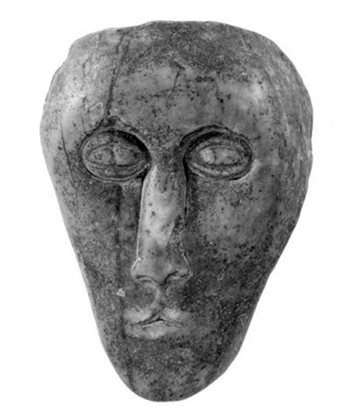Iron Age
A Face From The Past
A possible Iron Age anthropomorphic stone carving from Trabolgan, Co. Cork
By Donna GilliganThe original register entry for this object reads: “1971:904 - Stone head carved on split pebble. Roughly trapezoidal in shape. The uncarved surface is somewhat concave, though irregular, the carved surface is convex. The long sides are facetted. Both the eyes are carved in false relief, both the upper and the lower lids being clearly indicated by a thin line. The nose is in relief: it is long and relatively broad although somewhat irregular. Both nostrils are clearly indicated. The lips, in very low relief, are pursed, the effect is similar to that of a hare lip. Max. L. 9.3cm; Max. W. 5.7cm; Min. W.(at chin) 3.3 cm; Max. T. 2.4cm. Found in bank of ringfort.”
This object, a small curious representation of a human face, is thought to date from the Iron Age period. Stone carvings prove a difficult artefact type to date with absolute certainty, and their identifications are usually gained from research and comparison of known confirmed examples of that era.

Iron Age Stone Sculpture
Stone sculpture from the Iron Age period is generally represented in two forms – iconic, such as human and animal deific representations, and aniconic, such as pillar-stones like the Turoe Stone. The majority of Celtic iconic carvings feature a human head with a varying numbers of faces. These head carvings often share a number of characteristics in their appearance, the comparison of which can aid in their dating and identification.
Characteristics include simplified, sometimes crude, features including long faces, closely-set rounded or oval eyes (sometimes heavily lidded), broad, long noses and slit mouths. Their simplified, blank, and often stern faces have been thought to evoke “the stern and brooding presence of an Otherworld being” (Raftery, 186).
The Iron Age “Head Cult”
Severed head motifs recur frequently within the decoration of Celtic art and artefacts. The existence of the presence of a Celtic “Head Cult” during the Iron Age has long been a proposed theory suggested by some to explain the Celtic veneration and idolisation of the human head in their art, craftsmanship and physical practices.
It is assumed that the Celts believed the human head to be the seat of the soul, and thus symbolic of otherworld powers and divinity. This theory has been strengthened by records detailing the Celtic practice of head-hunting. This practice, recorded in classical writings by scholars, has been given potential credence by examples of the archaeological burial record for this period. Decapitated human skulls found on Iron Age sites – such as those at Loughnashade – have presented the possibility that the severed human head may have had connections to rituals and sacrifices in Celtic society.
Whether or not a cult of the head actually existed during this period, we can infer that Iron Age society placed a specific reverence, symbolism or favour upon the head motif, which was reflected in their artistic expressions and craftsmanship.
Similar examples for comparison
The records for this object note that its potential Iron Age date was suggested by Dr. Anne Ross, due to similarities to a number of known examples of this period from Britain. Her analysis identified visual characteristics of the typology, and highlighted a number of similar styles. Heads carved onto portable pebbles have previously been found, and, of these examples, one in particular from Thaxted, Essex, forms a close comparison to this object. Of particular interest is the fact that the Thaxted head is recorded as having been discovered with a disarticulated human skull.
However, the discovery of the Trabolgan head within a ringfort (an Early Christian enclosure) poses problems with assigning an Iron Age date with certainty. The Celtic head motif can be seen to have continued into Early Christian art, examples of which can be seen in decorative metalwork such as The Tara and Cavan brooches, as well as on carved ecclesiastical stonework such as the Clonfert doorway. Thus the possibility remains that this object may also date to the early medieval period.
Learn More
This object is not currently on public display as it is part of the museum’s reserve collections.
The Corleck Head, an Iron Age carved stone head, can be seen in The Treasury, at the National Museum of Ireland - Archaeology.
You can also encounter real Iron Age faces in our Bog Bodies exhibition!
References
- Raftery, Barry (1994) Pagan Celtic Ireland: The Enigma of the Irish Iron Age, Thames & Hudson.
- Ross, Anne (1967) Pagan Celtic Britain: Studies in Iconography and Tradition, London: Routledge and Kegan Paul.
- Rynne, Etienne (1972) Celtic Stone Idols in Ireland, Pg. 79-98, In: Thomas, Charles (Ed.) (1972) The Iron Age in the Irish Sea Province: papers given at a C.B.A. conference held at Cardiff, January 3 to 5, 1969, Council for British Archaeology, London.
Location:
A Face From The Past is located at:
In Storage
Previous artefact:
Delicate and Beautiful Japanese Wood-Block Print by Hokusai
Next artefact:
A Fossil Crinoid: Dimerocrinus Decadactylus
